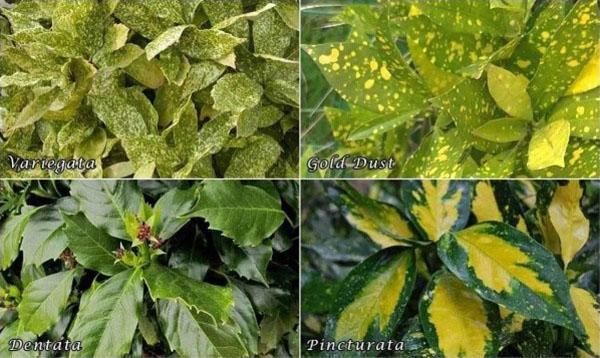Aucuba japonica is a luxurious plant for your home
 If you prefer evergreens with decorative foliage, get yourself a Japanese Aucuba. Its chic crown will decorate the room all year round. In addition, with some effort, it will also delight you with beautiful fruits. What is so special about this flower and what does it need for indoor growing?
If you prefer evergreens with decorative foliage, get yourself a Japanese Aucuba. Its chic crown will decorate the room all year round. In addition, with some effort, it will also delight you with beautiful fruits. What is so special about this flower and what does it need for indoor growing?
Description of the plant
Aucuba japonica is one of the most popular plant species used in indoor floriculture. It grows, like other varieties, in a bush, with flexible, but strong, branches. It is noteworthy that the shoots retain the original green color of the bark even when lignified. The main advantage of the aucuba is its foliage. It has an oval shape, the width of the plate reaches 6 cm with a length of up to 20 cm. Most often, the edges of the leaves are serrated, but there are types with even leaves.
The color of the foliage is bright green, but spots are scattered in a chaotic manner over the entire surface of the plate. They can be both small and quite large, but always have a golden color. Aucuba bloom is inconspicuous, but when pollinated, interesting fruits in the form of red berries are tied.
Aucuba fruiting is possible only if there are two plants of different sexes.
Varietal variety of Japanese aucuba
Currently, many varieties of culture have been bred. They differ in the shape of the leaves and their color. Some of the most beautiful varieties of the Japanese aucuba are:
- Daisuke's Tiger with serrated leaves, in which a golden speck is located along the edge of the plate;
- Natsu-no-kumo with two-colored leaves (the lower ones are green, the upper ones are yellow-golden);
- Ooba Nakafu with large leaves, in which only the edge of the leaf is green and the middle is yellow;
- Gold Dust with highly spotted leaves and a barely visible green background;
- "Hillieri" with solid dark green foliage.
Aukuba Japanese: what does culture love?
The plant can be considered a leader in unpretentiousness. It is capable of developing both in a sunny place and in the shade. It is noteworthy that the lack of lighting has absolutely no effect on the appearance of the bush. Shoots do not stretch, and development occurs evenly. Changes are possible only in the color of variegated varieties. The spots become more blurred and pale. Even in the shade, the flower does not bloom well and bears fruit. However, this rarely happens at home.
The only requirement of the aucuba is a cool hibernation. However, she will spend the winter quite normally in a warm room. In the latter case, you just need to provide high humidity and good lighting.
Regarding watering, in the summer you need to moisten the soil more often. In a cool room (in winter) watering and should be rare at all. The bush does not need frequent spraying - dry air is not terrible for it, but only if it is not wintering in a warm place. Then it should be sprayed regularly.